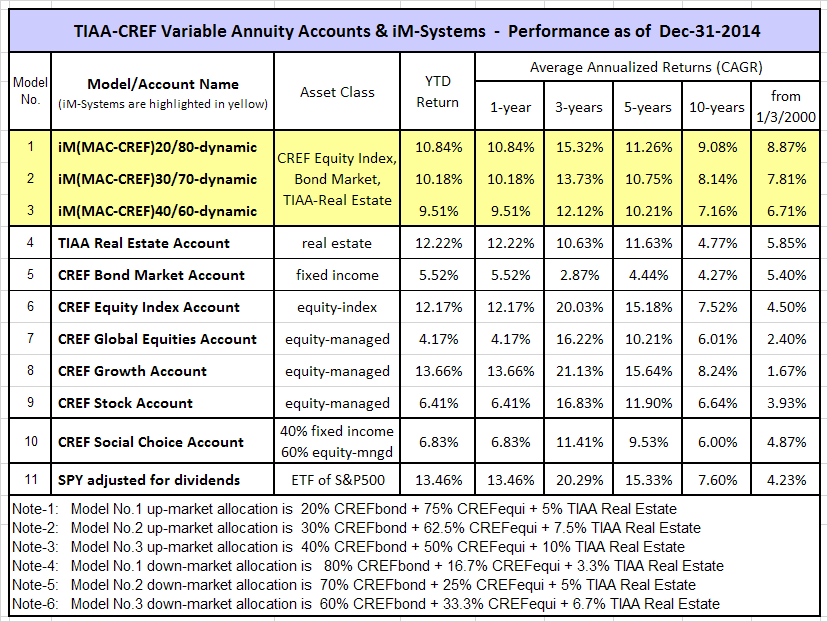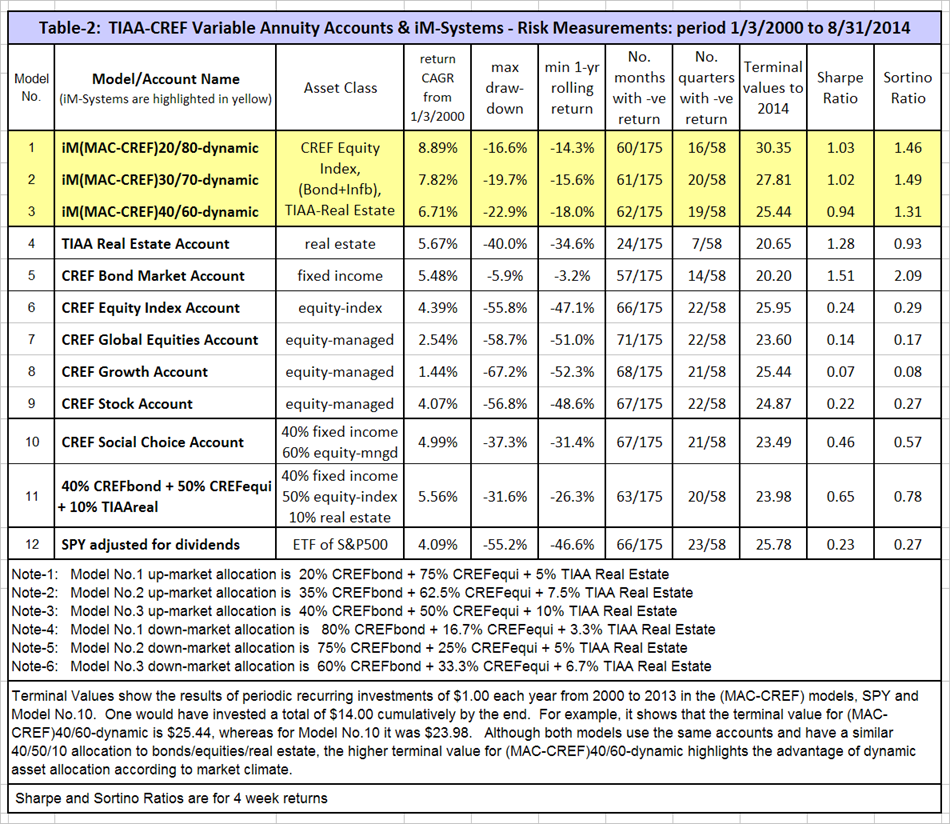TIAACREF Asset Allocation
Post on: 27 Апрель, 2015 No Comment

I am saving for retirement through my universitys 403(b) plan administered by TIAA-CREF. With all the investment options open to me, how do I best allocate my money among the various mutual funds and annuities to ensure that I am properly diversified? How many funds do I need to invest in, and how should I divvy up my money?
* * *
Brett Hammond
Chief Investment Strategist
Investment Strategy and Client Solutions, TIAA-CREF
Choosing the right allocation of assets is one of the most important decisions an investor can make. In terms of overall portfolio performance, your decisions about allocating effectively among different assets often carry a lot more weight than your ability to pick specific investment funds.
However, with the growing number of investment options, it can be very difficult to know where to put your money. Though there is no one size fits all formula for investors, TIAA-CREF can suggest some general guidelines to help ensure proper diversification. 1
Know Your Tolerance for Risk
One of the benefits of a sound asset allocation strategy is the ability to manage risk. When your portfolio is properly diversified, the upward movement of one asset class can help offset the downward movement of another during changing economic and market conditions, thus helping to keep the portfolio’s overall performance in line with your risk and return objectives.
How much risk are you comfortable handling? TIAA-CREF’s Asset Allocation Evaluator can help you find out and then suggest an asset mix based on your answers to questions about investment horizon, your personal circumstances, and outlook on market volatility.
After that, you should thoroughly research your investment options among the five primary asset classes: equities, fixed income, money market, guaranteed and real estate.
Gain Insights into Your Investments
Generally, if you are a long-term investor with many years to go until retirement, you will want to allocate a certain portion of your assets to equities. Even after you retire, you may decide to stay invested in equities to keep that growth potential in your portfolio. Equities can be more volatile than other investment types, but remember that even within an asset class you can adjust how much risk you are willing to take; a large-cap value fund, for example, will likely carry less risk than a small-cap growth fund or an emerging markets fund.
Many TIAA and CREF investment options are broadly diversified in and of themselves. And many of our mutual funds and annuity accounts offer exposure to investments that individual investors generally can’t find elsewhere. For example, the TIAA Real Estate account directly owns a diverse nationwide portfolio of commercial property such as office buildings in New York City and other major metropolitan areas. The CREF Stock account maintains a wide range of holdings, including both US and international equities. The TIAA Traditional Annuity guarantees your principal while also paying out a contractually specified interest rate, plus the opportunity for additional amounts as declared on a year-by-year basis. TIAA Traditional’s returns and guarantees are backed by the financial strength and claims paying ability of TIAA. (The TIAA General Account invests in a broadly diversified portfolio of corporate and government bonds and preferred stock, including oil and gas, manufacturing, utilities, services, mining and transportation holdings, and commercial real estate investments and other securities.)
Other funds or accounts may be more narrowly focused and provide more limited asset-class exposure. If you choose to invest in these types of funds or accounts rather than more broad-based, multi-asset class investments, you should look to ensure sufficient diversification among various asset classes. And always remember to examine the underlying investments; many equity funds, for example, often invest in the same large companies, meaning losses from a particular stock may be magnified for investors who hold multiple funds that own that stock.
Consider a Target Date Fund for Simplicity
Another alternative may be TIAA-CREF’s Lifecycle Funds, which offer an easy solution for a retirement investor seeking diversification. Lifecycle Funds are also known as target date maturity funds because they are structured as funds of funds whose asset mix changes over time to achieve a certain asset allocation corresponding to when the investor reaches retirement. As with all mutual funds, the principal value in a Lifecycle Fund is not guaranteed. Also, note that the target date of the Lifecycle Fund is an approximate date when investors may begin withdrawing from the fund. 2
The TIAA-CREF Lifecycle Funds start with an allocation of 90 percent to equity mutual funds and 10 percent to fixed income mutual funds for investors with a timeframe of 25 years or more until retirement. After holding at that allocation for a few years, the funds are designed to gradually reallocate more money to fixed income funds, until the target retirement rate is reached. We have funds ranging from planned retirement dates of 2010 to 2050.
Rebalance Annually

No matter what asset allocation you choose, it’s important to rebalance your portfolio at least once a year. (The Lifecycle Funds rebalance automatically.) Rebalancing does not protect against losses or guarantee that an investor’s goal will be met, but it can help your portfolio stay on track. Market fluctuations in various asset classes can throw your asset allocation out of balance, meaning you may need to sell or buy certain assets to return to the risk/reward balance you were originally most comfortable with.
Get Objective Advice
If you need help planning your investment strategy, or if you would simply like a financial check up to make sure your portfolio is properly diversified, we encourage you to speak with a TIAA-CREF consultant. Our consultants receive no commissions. TIAA-CREF compensates the consultants through a salary-plus-incentive program based on client service excellence and financial results. Consultants will only recommend products that help achieve our clients goals.
Your consultant will show you how TIAA-CREF’s objective, personalized investment advice can provide asset allocation, fund selection and savings rate recommendations that are appropriate to your stage in life. You can use our advice to evaluate investment options not only from TIAA-CREF but from other financial services firms as well. Best of all, our advice is available to you absolutely free of charge. Learn more here.
Learn More
- To schedule an appointment with a TIAA-CREF consultant near you, please sign up online or call 800 842-2776 .
- Visit our Learning Center. which includes articles on asset classes, rebalancing techniques and asset allocation strategies.
TIAA-CREF products may be subject to market and other risk factors. See the applicable product literature, or visit www.tiaa-cref.org for details.
You should consider the investment objectives, risks, charges and expenses carefully before investing. Please call 877 518-9161, or go to www.tiaa-cref.org for a current prospectus that contains this and other information. Please read the prospectus carefully before investing.
TIAA-CREF Individual & Institutional Services, LLC and Teachers Personal Investors Services, Inc. members FINRA, distribute securities products. Annuity contracts and certificates are issued by Teachers Insurance and Annuity Association (TIAA) and College Retirement Equities Fund (CREF), New York, NY.
1 Diversification is a technique to help reduce risk. There is no absolute guarantee that diversification will protect against a loss of income.
2 Approximately seven to ten years after a Lifecycle Funds target date, the fund may merge into the Lifecycle Retirement Income Fund or a similar fund.














